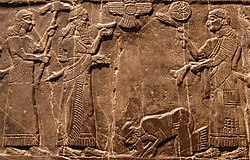Salmanassar III.
| Salmanassar III. | |
|---|---|
 | |
| Narození | 9. století př. n. l. |
| Úmrtí | 824 př. n. l. |
| Potomci | Šamší-Adad V., Aššur-dan-apli |
| Otec | Aššurnasirpal II. |
| Matka | Mullissu-mukannišat-Ninua |
| Některá data mohou pocházet z datové položky. | |
Salmanassar III., nazývaný také Šulmánu-ašaridu, vládl asyrské říši od roku 858 př. n. l. do roku 824 př. n. l. po svém otci Aššurnasirpalovi II., který mu zanechal rozsáhlou říši na vrcholu své moci. Díky své dlouhé vládě a vojenským úspěchům patří mezi nejvýznamnější asyrské panovníky.
Během své dlouhé vlády vedl mnoho výprav do takřka všech okolních zemí – hlavně do Babylonie a Sýrie. Pyšnil se, že 25× překročil Eufrat při tažení na západ. Až na Damašek mu patřila vlastně celá Sýrie a Kanaán, kde porazil i izraelského krále Achaba. Na severozápadě, v Malé Asii, obsadil významná centra Tarsos a Kommagéné. Několik výprav směřovalo na východ do zemí Parsua a Mannea, které se mu však nepodařilo zcela podmanit. Na severu podnikal výpravy proti mocnému státu Urartu, který porazil, a dobyl jeho hlavní města Sugunii a Arzaškun.[1]
Na jihu uznával jeho svrchovanost většinou i Babylón, avšak tamní situace byla velmi výbušná.

Vojenská tažení
Bitva u Qarqar
Jeho velkým soupeřem byl vládce Damašku Barhadad (Hadadazer), kterého nikdy neporazil. Roku 853 př. n. l. se několik králů spolčilo proti Salmanassarovi III. a tato koalice se s ním utkala v bitvě u Qarqar. Mezi koalici patřil Hadadazer (král Damašku), Irhuleni (král Hamá), Achab (král Izraele), Gindibu (král Arabů) a další. Bitva skončila nerozhodně.
Povstání v Babylonii
Za vlády Salmanassara III. v Asýrii vládl v Babylonii Marduk-zakir-šumi. Roku 851 př. n. l. povstal Marduk-bel-ušate, bratr Marduk-zakir-šumiho, proti svému bratrovi a ovládl oblast Dijály.
[2] Marduk jel poté na pomoc svému spojenci Marduk-zakir-šumimu a jeho vzbouřeného bratra porazil a zabil.[3] Toto zmínil na Černém obelisku.

Svého syna oženil s babylonskou princeznou Šammuramat (Semiramis).
Vzpoura v Asýrii
Ke konci života vypuklo povstání vedené nejstarším synem Aššur-dan-aplim, které porazil až jeho syn Šamši-Adad V., krátce na to Salmanassar III. zemřel. Rozsah rebelie byl do té doby nevídaný – odpadlo i Ninive a Aššur.
Odkazy
Reference
Externí odkazy
 Obrázky, zvuky či videa k tématu Salmanassar III. na Wikimedia Commons
Obrázky, zvuky či videa k tématu Salmanassar III. na Wikimedia Commons - Black obelisk of Shalmaneser III inscriptions anglický překlad nápisů z Šalmanassarova černého obelisku (nyní ve sbírkách British Musea v Londýně)
| Asyrský král | ||
|---|---|---|
| Předchůdce: Aššurnasirpal II. | 858–824 př. n. l. Salmanassar III. | Nástupce: Šamši-Adad V. |
Média použitá na této stránce
Autor: Bjørn Christian Tørrissen, Licence: CC BY-SA 3.0
Basalt statue of King Shalmaneser III, 858-824 BCE (Neo-Assyrian Period). Found in Assur (Qala't Sharqat). Today it is displayed in the Istanbul Archaeological Museums, in the Museum of the Ancient Orient section. This text is from a display at this statue, a translation of script on the actual statue:
The king gives a brief account of his genealogical titles and characteristics as follows:
"Shalmaneser, the great king, the mighty king, king of all the four regions, the powerful and the mighty rival of the princes of the whole universe, the great ones, the kings, son of Assur-Naşirapli, king of universe, king of Assyria, grandson of Tukulti-Ninurta, king of universe, king of Assyria."
The inscription continues with describing his campaigns and deeds of the lands of Urartu, Syria, Namri, Que and Tabal, and ends with this:
"At that time I rebuilt the walls of my city Ashur from their foundations to their summits. I made an image of my royal self and set it up by the metal-workers gate."Autor: unknown, Licence: CC BY-SA 3.0
Depiction of Jehu King of Israel giving tribute to King Shalmaneser III of Assyria, on the Black Obelisk of Shalmaneser III from Nimrud (circa 827 BC) in the British Museum (London).
Autor: Osama Shukir Muhammed Amin FRCP(Glasg), Licence: CC BY-SA 4.0
The front panel of this dais depicts Shalmaneser III (r. 858-824 BCE), (on the right) handshaking Marduk-zakir-shumi (r. 855 - 819 BCE) (left), king of Babylon. Both are surrounded by guards and stand below a fringed canopy supported by poles. The scene commemorates Shalmaneser's support of Marduk-zakir-sumi against his rebellious brother, Marduk-bel-usati and the ascent of Marduk-zaki-shumi to the throne. Its place on the dais reflects its importance as one of the great achievements of Shalmaneser III. This dais was found in the eastern end of the throne room (T1) at Fort Shalmaneser in the city of Nimrud (in modern-day Nineveh Governorate, Iraq) in 1962 CE. The front and sides of the dais were carved in relief depicting various tributary scenes. The dais was completed around 846-845 BCE (and that would be the king's 13th year of reign). On display at the Iraq Museum in Baghdad, Iraq.



